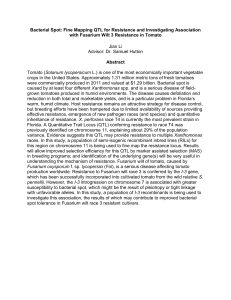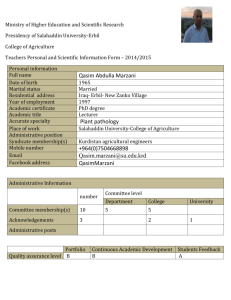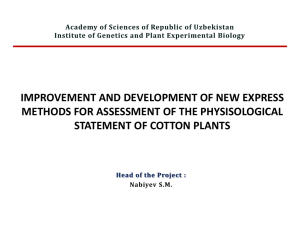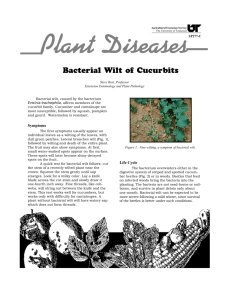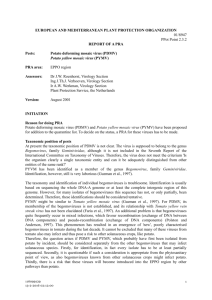L723 Wilt, Nematode, and Virus Diseases of
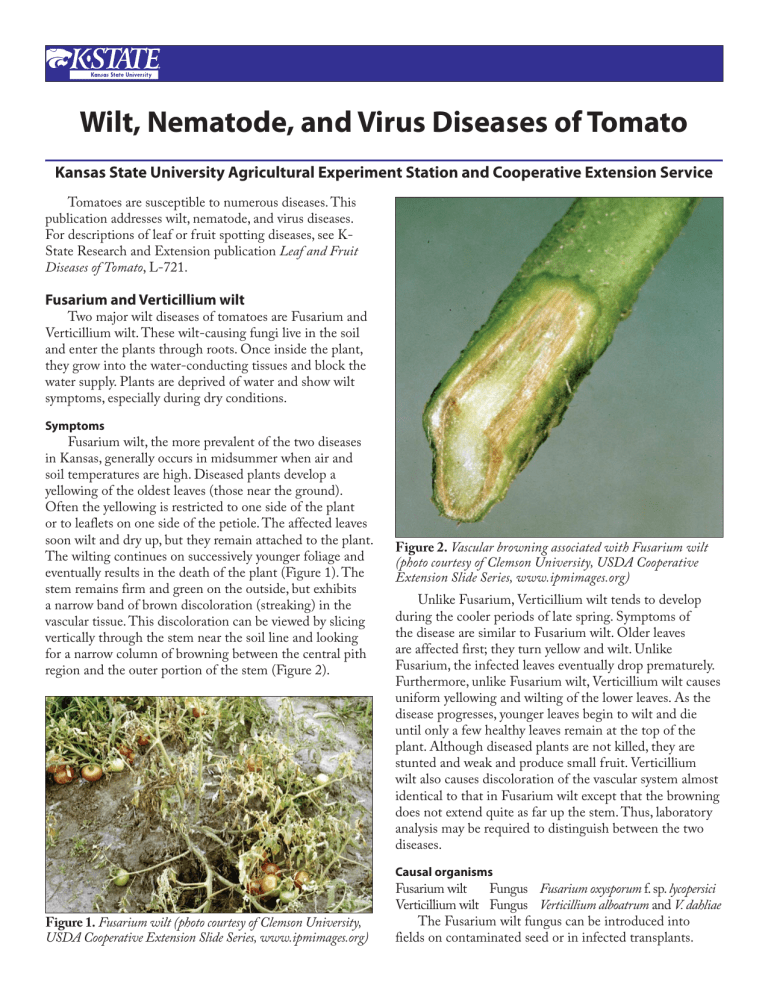
Wilt, Nematode, and Virus Diseases of Tomato
Kansas State University Agricultural Experiment Station and Cooperative Extension Service
Tomatoes are susceptible to numerous diseases. This publication addresses wilt, nematode, and virus diseases.
For descriptions of leaf or fruit spotting diseases, see K-
State Research and Extension publication Leaf and Fruit
Diseases of Tomato , L-721.
Fusarium and Verticillium wilt
Two major wilt diseases of tomatoes are Fusarium and
Verticillium wilt. These wilt-causing fungi live in the soil and enter the plants through roots. Once inside the plant, they grow into the water-conducting tissues and block the water supply. Plants are deprived of water and show wilt symptoms, especially during dry conditions.
Symptoms
Fusarium wilt, the more prevalent of the two diseases in Kansas, generally occurs in midsummer when air and soil temperatures are high. Diseased plants develop a yellowing of the oldest leaves (those near the ground).
Often the yellowing is restricted to one side of the plant or to leaflets on one side of the petiole. The affected leaves soon wilt and dry up, but they remain attached to the plant.
The wilting continues on successively younger foliage and eventually results in the death of the plant (Figure 1). The stem remains firm and green on the outside, but exhibits a narrow band of brown discoloration (streaking) in the vascular tissue. This discoloration can be viewed by slicing vertically through the stem near the soil line and looking for a narrow column of browning between the central pith region and the outer portion of the stem (Figure 2).
Figure 1.
Fusarium wilt (photo courtesy of Clemson University,
USDA Cooperative Extension Slide Series, www.ipmimages.org)
Figure 2.
Vascular browning associated with Fusarium wilt
(photo courtesy of Clemson University, USDA Cooperative
Extension Slide Series, www.ipmimages.org)
Unlike Fusarium, Verticillium wilt tends to develop during the cooler periods of late spring. Symptoms of the disease are similar to Fusarium wilt. Older leaves are affected first; they turn yellow and wilt. Unlike
Fusarium, the infected leaves eventually drop prematurely.
Furthermore, unlike Fusarium wilt, Verticillium wilt causes uniform yellowing and wilting of the lower leaves. As the disease progresses, younger leaves begin to wilt and die until only a few healthy leaves remain at the top of the plant. Although diseased plants are not killed, they are stunted and weak and produce small fruit. Verticillium wilt also causes discoloration of the vascular system almost identical to that in Fusarium wilt except that the browning does not extend quite as far up the stem. Thus, laboratory analysis may be required to distinguish between the two diseases.
Causal organisms
Fusarium wilt Fungus Fusarium oxysporum f. sp. lycopersici
Verticillium wilt Fungus Verticillium alboatrum and V. dahliae
The Fusarium wilt fungus can be introduced into fields on contaminated seed or in infected transplants.
Once introduced, the fungus can survive for many years in the soil. There are at least three known races or strains of
Fusarium. The term “race” refers to the organism’s ability to infect certain crop varieties but not others. Race 1 is known to occur in Kansas, and Race 2 likely occurs here. Race 3 could easily spread to Kansas.
The Verticillium wilt fungus also is a soilborne pathogen that can attack a wide range of plants, including potato, eggplant, strawberry, black raspberry, and many common weeds.
Both Fusarium and Verticillium invade the plant through the fibrous root system and disrupt water and mineral uptake within the plant. Infection and disease development in Fusarium wilt are favored by warm soil temperatures (80 degrees Fahrenheit) and low soil moisture while Verticillium wilt develops best at relatively cool
(55 to 75 degrees Fahrenheit) soil temperatures.
Control
There are several strategies for reducing the risk of
Fusarium and Verticillium wilt.
• Resistance : The most practical means of controlling
Fusarium and Verticillium wilt is the use of resistant varieties. Many of the popular varieties of tomatoes have resistance to the common race (Race 1) of the
Fusarium fungus, to the Verticillium fungus, or to both. A short list of resistant tomato varieties is
given in Table 1. Information on other varieties may
be obtained from seed catalogs. These varieties are usually marked “V” for Verticillium resistance and
“F” for Fusarium, with a number (1,2, and/or 3) corresponding to which races of Fusarium they are resistant to. There is growing interest in planting
‘heirloom varieties’ for their unique characteristics.
Unfortunately, many of these varieties are not resistant to Fusarium and Verticillium wilt.
• Crop Rotation: Long rotations (4 to 6 years) to nonhosts may help to reduce fungal population levels in the soil, but it will not completely control these diseases. Both organisms can survive for a long time in the soil, and Verticillium has a wide host range.
Rotate to cereal crops if possible and control weeds, which might be hosts.
• Sanitation: Remove and destroy diseased plant tissue at the end of the season. Clean up stakes, cages, and other items that hold soil and debris.
• Fertilization : (Mainly for Verticillium). Appropriate fertility and irrigation can help to maintain plant vigor and suppress disease.
Walnut wilt
Tomato, potato, alfalfa, and other herbaceous and woody plants can be afflicted with a disorder known as walnut wilt. This malady is associated with root uptake of a chemical called juglone, which is produced by several species of trees in the walnut family, including black walnut, Persian walnut, butternut, and pecan. Juglone is formed in the leaves, fruit hulls, inner bark, and roots of the walnut and is leached or released into the soil. This chemical has fungicidal and insecticidal properties. It also is quite toxic to many plant species and induces wilting and stunting.
The ability of plants to produce and release chemicals, which are toxic to other plants, is called allelopathy. The severity of the juglone toxicity partly depends on the distance from the plants to the walnut tree. Generally, tomatoes growing next to a walnut tree abruptly wilt and die in early- to mid-summer. Plants growing a short distance away may not be killed, but become wilted and stunted. The stem tissue of affected plants turns brown.
The symptoms of walnut wilt closely resemble those of
Fusarium and Verticillium wilt; however, the disorder may be distinguished from the other wilts by the constant association of walnut trees with the wilting symptoms.
Cause
Toxin (Juglone): produced by members of the walnut family.
Juglone may be leached from leaves and nuts into the soil during rain or released from roots. The chemical is highly reactive and is quickly inactivated in the soil. The major uptake of the toxin occurs when the tomato roots make contact with the roots of the walnut.
Control
Tomatoes or other susceptible plants should not be grown near black walnut or other trees that produce juglone. The removal of walnut trees may not have an immediate effect since the toxin can persist in the inner bark of roots for several years. Do not plant tomatoes for at least 2 years after the removal of walnuts.
Root knot nematode
Several species of root knot nematodes (microscopic worms) cause a stunting and wilting of many vegetables and ornamentals, including tomato, potato, eggplant, sweet potato, radish, geranium, and peony.
Symptoms
The disease typically appears in roughly circular patches in a field or garden, but may become more uniformly distributed when susceptible plants, such as tomato, are continuously planted in an area. Diseased tomato plants are stunted and have pale-green leaves. Diseased plants also may show symptoms of nitrogen, potassium, or phosphorus deficiencies even though adequate levels of these minerals are in the soil.
Severely infected plants wilt during hot daytime temperatures, then recover at night. The most characteristic symptoms of the disease occur below ground. Roots develop multiple small tan galls; these galls often fuse to cause extensive swelling
Figure 3.
Root galls and swelling caused by root knot nematode
(photo courtesy of Tom Zitter, Cornell University) and distortion of the root system (Figure 3). The roots also become much shorter and bushier than on healthy plants.
Causal organisms
Nematodes Meloidogyne spp.
Root knot nematodes are small, eel-like worms, which overwinter in the roots of perennial weeds or as eggs and larvae in soil or infected root debris. In the spring, larvae penetrate the roots and excrete a substance that induces the formation of root galls. Injury to the roots affects the uptake of water and minerals and eventually results in the development of aboveground symptoms described previously. Infection by the root knot nematode also may
“break” disease resistance to Fusarium and Verticillium wilt. Nematodes are more common in areas of Kansas south of Interstate 70.
Control
Root knot may be prevented by avoiding the introduction of the pathogen into the garden or field. Carefully check and discard any transplants showing swelling or galling of the roots. Never introduce soil into the garden
Table 1. Disease resistance to Verticillium Wilt (V), Fusarium wilt races 1, 2, and 3 (F) the root knot nematode (N), and tobacco mosaic virus (TMV) of tomato varieties popular in Kansas. (Taken from K-State Research and Extension
Publication MF-312, Tomatoes, April 2003). Consult seed catalogs for current listings.
F
Variety V (1,2,3) N TMV
Garden Tomatoes
Carolina Gold
Celebrity
Daybreak
Floralina
Jet Star
Merced
Mt Fresh
Mt Spring
Sun Leaper
Sun Start
Sunmaster
Sunny
Cherry Tomatoes
Cherry Grande
Mt Belle
Sweet Chelsea
Roma/Paste Tomatoes
Plum Dandy
Roma
Super Marzano
X
X
X
X
X
X
X = resistant, blank = non-resistant
1
1,2
1,2
1
1,2
1,2
X
X
X
X
X
X
X
X
X
X
1,2
1,2
X ???
X 1,2,3
1,2
1,2
1,2
1
1
1,2
1,2
1,2
X
X
X
X
X
X
X
X
X from areas where root knot is known to be a problem.
Rotation periods of 3 to 5 years with corn or other nonhost plants will reduce nematode populations in the soil.
Several varieties of tomato are available that have resistance to the root knot nematode (see Table 1). If the disease is a serious problem, soil fumigation may be required.
Virus diseases
Several virus diseases to tomato occur in Kansas, although they are not as common as the wilt and foliar diseases. Three of the more prevalent virus diseases are tobacco mosaic virus, cucumber mosaic virus, and tomato spotted wilt virus.
Symptoms
The tobacco mosaic virus (TMV) can attack a wide range of plants, including tomato, pepper, eggplant, tobacco, spinach, petunia, and marigold. On tomato, virus infection causes light and dark green mottled areas on the leaves (Figure 4). The dark green areas tend to be somewhat thicker than the lighter portions of the leaf. The leaf mottling is seen more easily if the affected plant surface is
Figure 4.
Leaf mottling due to infection by tobacco mosaic virus (TMV) (photo courtesy of Tom Zitter, Cornell
University)
Figure 5.
Shoestring-like appearance of tomato leaves infected by cucumber mosaic virus (CMV). (photo courtesy of Tom Zitter,
Cornell University)
Figure 6.
Wilting and dieback caused by tomato spotted wilt virus (photo by Megan Kennelly).
partially shaded. Stunting of young plants is common, and often is accompanied by a distortion and fern-like appearance of the leaves. Older leaves curl downward and may be slightly distorted. Certain strains of the virus can cause a mottling, streaking, and necrosis of the fruits. Infected plants are not killed but they produce poor quality fruit and low yields.
The cucumber mosaic virus (CMV) has one of the broadest host ranges of any of the viruses. The disease affects a number of important vegetables and ornamentals including tomato, pepper, cucumber, melons, squash, spinach, celery, beets, and petunia. Tomatoes infected with the cucumber mosaic virus develop a slight yellowing and mottling of the older leaves. Expanding leaves typically become twisted, curl downward, and develop a “shoestring” appearance as a result of a restriction of the leaf surface to a narrow band around the midrib of the leaf (Figure 5). Diseased plants are stunted and produce small quantities of fruit.
The tomato spotted wilt virus (TSWV) also has a wide host range and can affect a number of ornamental plants as well as tomato. Early symptoms of spotted wilt
Figure 7.
Pale, yellow concentric rings on unripe and ripe tomato fruit. (photo by Whitney Cranshaw, Colorado State
University, www.ipmimages.org) on tomato are difficult to diagnose. Young, infected plants may show an inward cupping of leaves and the foliage may appear off-color or have a slight bronze cast. As the disease progresses, plants may develop dark brown to black streaks on the main stem. Occasionally the top portion of the plant wilts (Figure 6). The most characteristic symptom of spotted wilt appears on the fruit. On young fruit, white to yellow concentric rings, ½ inch in diameter, develop on the fruit skin. The area within the ring typically is raised, which gives the fruit a bumpy or warty appearance. The bright yellow rings on red, mature fruit are quite striking and are easily diagnosed as spotted wilt (Figure 7).
The leaf distortion associated with some of viral diseases often is confused with injury resulting from phenoxy herbicide exposure. Generally a phenoxy herbicide
(2,4-D) will uniformly affect all tomato plants in a garden or greenhouse. However, unusual air-flow patterns can cause patchy symptoms. The herbicide also will cause leaf distortions on a number of other broadleaf plants in the area. Plants exposed to low levels of the herbicide may recover. In contrast, virus diseases normally will not affect
all plants at the same time, or cause injury to other types of plants in the area. Once the plant is infected it will not recover.
Causal agents
Tobacco mosaic virus (TMV), cucumber mosaic virus
(CMV), and tomato spotted wilt virus (TSWV).
TMV: The tobacco mosaic virus is very stable and can persist in contaminated soil, in infected tomato debris, on or in the seed coat, and in manufactured tobacco products.
The virus is transmitted readily from plant-to-plant by mechanical means. This may simply involve picking up the virus while working with infected plant material, then inoculating healthy plants by rubbing or brushing against them with contaminated tools, clothing, or hands. Aphids are not vectors of the virus, although certain chewing insects may transmit the pathogen.
CMV: The cucumber mosaic virus overwinters in perennial weeds and may be transmitted to healthy plants by aphid vectors (although tomatoes are not the preferred host of aphids) or by mechanical means. The cucumber mosaic virus cannot withstand drying, or persist in the soil.
It also is more difficult than tobacco mosaic to transmit mechanically. Thus, cucumber mosaic tends to progress more slowly than tobacco mosaic in a field or garden.
TSWV: Tomato spotted wilt virus is transmitted from plant to plant by several species of small insects called thrips. Thrips are less than ¼ inch long, light green to brown, and are extremely difficult to find on the plants.
Several weedy hosts and ornamental plants may serve as alternate hosts for the virus.
Control
Virus diseases cannot be controlled once the plant is infected. Therefore, every effort should be made to prevent introduction of virus diseases into the garden.
Resistance: Resistance to TMV is available. Choose
cultivars with resistance (see Table 1).
Sanitation: Sanitation is key for prevention of all three virus diseases. Infected plants should be removed immediately to prevent spread of the pathogens.
Weed control: Perennial weeds, which may serve as alternate hosts, should be controlled in and adjacent to the garden.
Avoid tobacco: The use of tobacco products during cultural practices should be avoided to prevent inoculation of plants with the tobacco mosaic virus. Those people using tobacco or working with infected plant material should wash their hands thoroughly in soapy water before handling tomato plants.
Insect control: Control of insects, especially aphids and thrips, will help reduce the likelihood of cucumber mosaic and spotted wilt.
Megan Kennelly
Plant Pathologist
Department of Plant Pathology
Brand names appearing in this publication are for product identification purposes only. No endorsement is intended, nor is criticism implied of similar products not mentioned.
Publications from Kansas State University are available on the World Wide Web at: www.oznet.ksu.edu
Contents of this publication may be freely reproduced for educational purposes. All other rights reserved. In each case, credit
Megan Kennelly, Wilt, Nematode, and Virus Diseases, Kansas State University, March 2007.
Kansas State University Agricultural Experiment Station and Cooperative Extension Service
L-723 March 2007
K-State Research and Extension is an equal opportunity provider and employer. Issued in furtherance of Cooperative Extension Work, Acts of May 8 and June 30, 1914, as amended. Kansas State University, County Extension Councils, Extension Districts, and United States Department of Agriculture Cooperating, Fred A. Cholick, Director.
